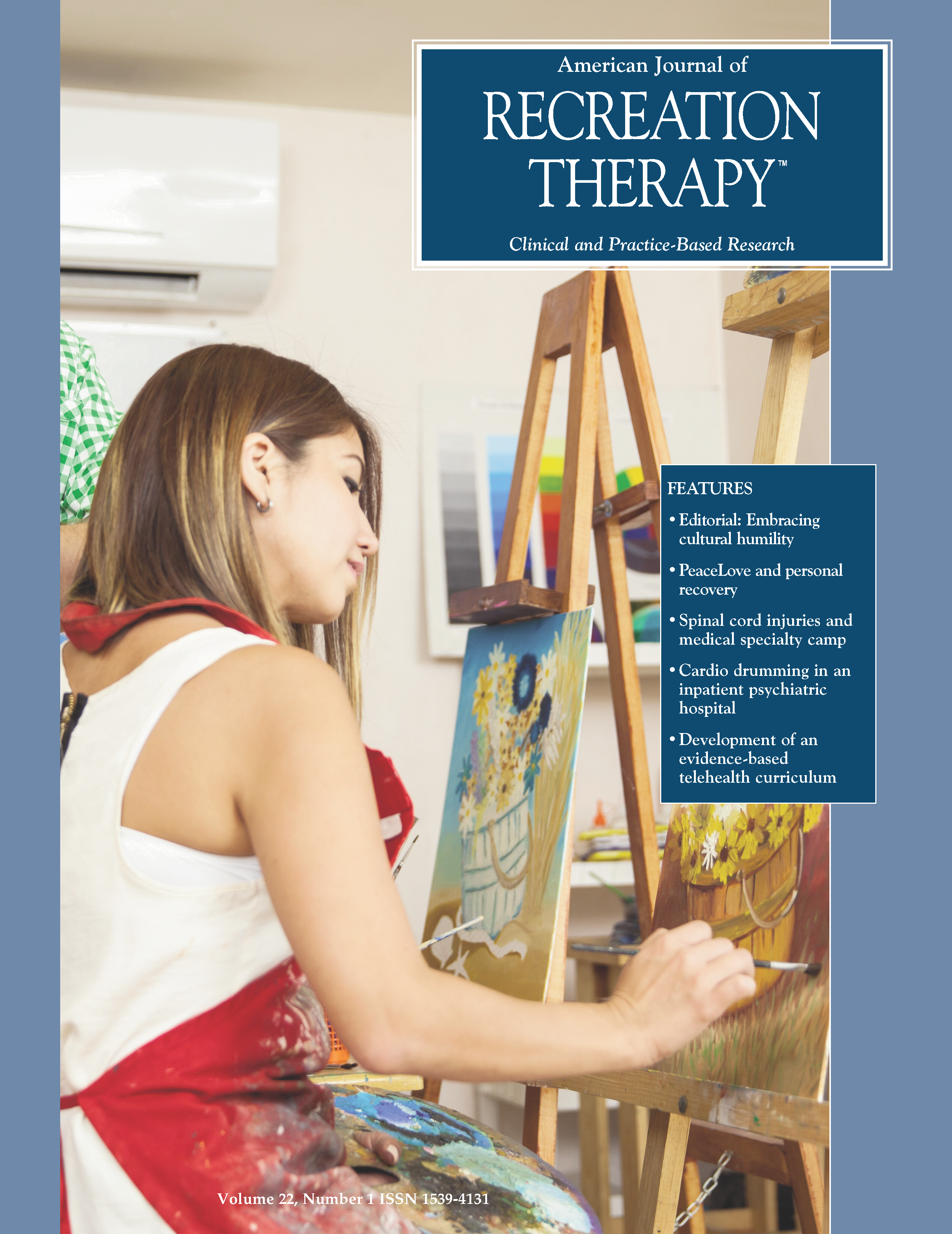An egocentric social network analysis of individuals with spinal cord injuries attending a medical specialty camp
DOI:
https://doi.org/10.5055/ajrt.2023.0276Keywords:
spinal cord injury, egocentric social network analysis, ego, alter, medical specialty campAbstract
Social connectedness may be a barrier for people with disabilities and can vary based on diagnosis. People with traumatic spinal cord injuries (SCIs) pose a unique perspective to this concept as they have, at one point, lived as an individual without a disability. This study examined individuals with a range of duration and severity of injury, evaluating how attendance at a disability-specific summer camp may affect participants’ social networks. This study applied an egocentric social network analysis to better understand the alters these individuals go to for important matters in their lives. Through the completion of an adapted version of the Health and Important Matters Social Network Battery, the responses of 14 research subjects were recorded and analyzed. This study found that many of the participant’s social networks consisted of friends and family with whom they had built friendships with prior to their injury. This finding was contrary to previous research findings, indicating that it would be likely that networks would consist of multiple individuals from the medical specialty camp. The findings serve as a guide to help better understand the diverse social networks of people with traumatic SCIs with implications to recreational therapy practice.
References
Dijkers M: Quality of life of individuals with spinal cord injury: A review of conceptualization, measurement, and research findings. J Rehabil Res Dev. 2005; 42(3): 87-110.
Gill M: Psychosocial implications of spinal cord injury. Crit Care Nurs Q. 1999; 22(2): 1-7.
Amati V, Meggiolaro S, Rivellini G, et al.: Social relations and life satisfaction: The role of friends. Genus. 2018; 74(7): 1-18.
NSCISC: Spinal cord injury facts and figures at a glance. Available at https://www.nscisc.uab.edu/Public/Facts%20and%20Figures%20-%202021.pdf. Accessed November 22, 2022.
Newman SD, Li C, Krause JS: Social isolation after spinal cord injury: Indicators from the longitudinal aging study. Rehabil Psychol. 2016; 61(4): 408-416.
Hitzig SL, Cimino SR, Alavinia M, et al.: Examination of the relationships among social networks and loneliness on health and life satisfaction in people with spinal cord injury/dysfunction. Arch Phys Med Rehabil. 2021; 102: 2109-2116.e1.
Guilcher SJT, Craven C, Basset-Gunter RL, et al.: An examination of objective social disconnectedness and perceived social isolation among persons with spinal cord injury/dysfunction: A descriptive cross-sectional study. Disabil Rehabil. 2021; 43(1): 69-75.
Tough H, Fekete C, Brinkhof M, et al.: Vitality and mental health in disability: Associations with social relationships in persons with spinal cord injuries and their partners. Disabil Health J. 2017; 10: 294-302.
Braaf S, Lennox A, Nunn A, et al.: Social activity and relationship changes experienced by people with bowel and bladder dysfunction following spinal cord injury. Spinal Cord. 2017; 55(7): 679-686.
Barclay L, McDonald R, Lentin P, et al.: Facilitators and barriers to social and community participation following spinal cord injury. Aust Occup Ther J. 2016; 63(1): 19-28.
Guilcher SJT, Casciaro T, Lemieux-Charles L, et al.: Social networks and secondary health conditions: The critical secondary team for individuals with spinal cord injury. J Spinal Cord Med. 2012; 35(5): 330-342.
Dawson S, McCormick B, Li J: A network analysis of youth with physical disabilities attending a therapeutic camp. Ther Recreat J. 2018; 52(2): 154-169.
Festinger L: Social comparison theory. Select Expos Theory. 1957; 16: 14-17.
Burgette JM, Rankine J, Culyba AJ, et al.: Best practices for modeling egocentric social network data and health outcomes. Health Environ Res Des J. 2021; 14(4): 18-34.
Perry BL, Pescosolido BA: Functional specificity in discussion networks: The influence of general and problem-specific networks on health outcomes. Soc Netw. 2010; 32(4): 345-357.
Pescosolido BA, Gardner CB, Lubell KM: How people get into mental health services: Stories of choice, coercion and “muddling through” from “first-timers.” Soc Sci Med. 1998; 46(2): 275-286.
Marsden PV: Egocentric and sociocentric measures of network centrality. Soc Netw. 2002; 24(4): 407-422.
Peng S, Roth AR, Perry BL: Random sampling of alters from networks: A promising direction in egocentric network research. Soc Netw. 2023; 72: 52-58.
Smith EJ, Marcum CS, Boessen A, et al.: The relationship of age to personal network size, relational multiplexity, and proximity to alters in the Western United States. J Gerontol Ser B Psychol Sci Soc Sci. 2015; 70(1): 91-99.
Gürog˘lu B: The power of friendship: The developmental significance of friendships from a neuroscience perspective. Child Dev Perspect. 2022; 16(2): 110-117.
McPherson M, Smith-Lovin L, Cooks JM: Birds of a feather: Homophily in social networks. Annu Rev Sociol. 2001; 27: 415-444.
Dawson S: Psychosocial Effect of a Year Round Mentoring & Online Support Program for Adolescents with Physical Disabilities Attending a Residential Medical Camp [dissertation]. Indiana University, 2018.
Published
How to Cite
Issue
Section
License
Copyright 2000-2025, Weston Medical Publishing, LLC and American Journal of Recreation Therapy. All Rights Reserved.


